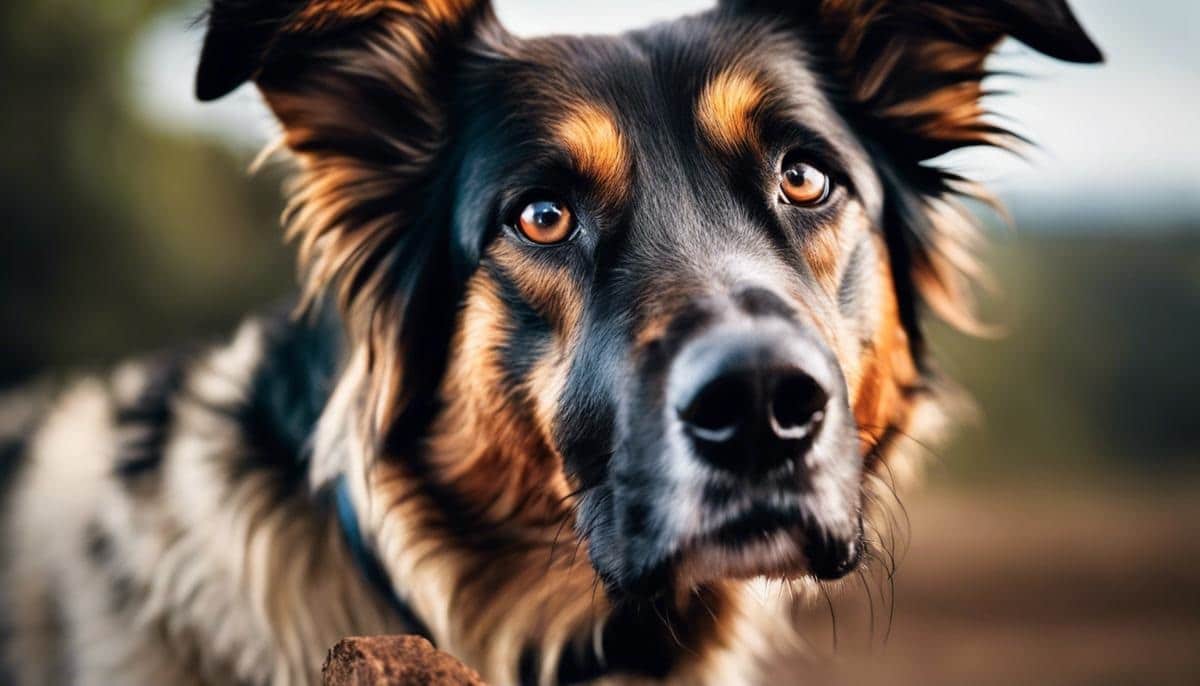
As devoted pet owners, we often view our canine companions as fearless protectors and happy-go-lucky friends. However, it’s important to recognize that dogs, much like humans, can experience a range of emotions, including fear. Fear of the outdoors is not uncommon among dogs and can stem from various sources, ranging from past trauma to a simple lack of exposure. This essay seeks to unravel the complex layers of canine fear and anxiety, provide strategies for overcoming these challenges, and offer insight into the critical role of diet and exercise in maintaining a dog’s mental health. By addressing these concerns with compassion and knowledge, we can help our four-legged friends live fuller, happier lives outside the confines of home.
Unraveling the Mystery: Why Do the Great Outdoors Spook Our Canine Companions?
As a seasoned veterinarian with a decade of encounters and insights, it’s clear that the vast world beyond our doorsteps can sometimes be a source of stress for our four-legged friends. Whether it’s the bustling city streets or the tranquil trails, dogs can exhibit signs of fear and anxiety when they step outside. But what exactly flips the switch on their distress?
First off, let’s crack the code on a dog’s perception. For starters, they have a keen sense of smell and hearing that we can only dream of. When a dog enters the outdoors, it’s bombarded with a cacophony of sounds and a tapestry of scents. This sensory overload can be the first trigger for an anxiety episode. Imagine trying to focus while a million radio stations played at once!
Unexpected sounds such as thunder, construction noise, or even the frantic energy of a crowd can set off a dog’s built-in alarm system. It’s a survival instinct – loud noises could mean danger. Therefore, for our furry pals with more jittery temperaments, these outdoor symphonies quickly become too much to handle.
Then we have what’s called a “lack of socialization.” Dogs who aren’t introduced to a variety of environments, people, and other animals during their crucial formative period – typically the first three to fourteen weeks – might grow up unsure about the world outside their front door. The unfamiliarity of an environment can evoke fear because it whispers of unpredictability and potential threats at every turn.
Aside from the sensory and social factors, past trauma also plays a part. A dog with an unpleasant experience tied to the outdoors, like a prior injury or frightening encounter, might start to associate all outdoor excursions with that negative event. It’s the canine equivalent of getting a food aversion after a bout of food poisoning – one bad experience, and you’re off it for good.
Lastly, certain breeds are simply more prone to anxiety than others due to their genetic makeup. For example, the petite Chihuahua or the vigilant German Shepherd may be more likely to feel threatened by the vastness and bustle of the big, wide world.
The important thing to remember is that anxiety isn’t just a case of the jitters; it’s a real concern for pets and can affect their well-being profoundly. Luckily, it’s not an insurmountable problem. With patience, positive training, proper socialization, and at times the help of a trained professional, our dogs can learn to navigate the great outdoors as bravely as they greet their food bowl at dinner time. After all, every dog deserves to enjoy a romp or a relaxed stroll in the fresh air, just as much as they relish a good belly rub.
Behavioral Training and Desensitization Techniques
Paving the Path to Pawsitive Outdoor Adventures: Behavioral Training and Desensitization for Anxious Canines
For our four-legged friends, stepping paw into the great outdoors should be an adventure filled with tail wags and sniffs aplenty. Yet, for some, what lies beyond the safety of their home is a world teeming with the unknown, causing their tails to tuck and their paces to falter. It is our duty to guide them through these fears with the tools of behavioral training and desensitization, turning trepidation into jubilation one step at a time.
When conquering fear of the outdoors, the role of behavioral training is akin to teaching a pup new tricks—only the trick here is confidence. Initiate this training with small, controllable outdoor experiences. Engaging in playtime a few steps outside the door or offering treats and affection can create positive associations. Gradually increasing the exposure, always at a pace where the canine compadre remains comfortable, reinforces the idea that the world outside is not a big, bad place.
Next, enter desensitization, a steady friend to behavioral training. This method is the art of acquainting a dog with the elements of outdoors in bite-size pieces. Begin by leaving the door open, encouraging natural curiosity to bubble. With an arsenal of soothing affirmations and favorite goodies, allow the dog to slowly approach the threshold on their own terms. A cozy outdoor dog bed nearby could serve as a personal oasis for a dog to observe the world from a safe space.
Combining behavioral training with desensitization creates a comprehensive approach. Implementing controlled exposure to outdoor sounds through recordings played at a low volume can help. As the dog grows more accustomed, gradually increase the volume over several sessions. Moreover, introducing outdoor elements, such as leaves or grass, inside the home bridges the gap between indoor comfort and outdoor exploration.
Remember the power of routine; consistent, short outings build a rhythm that dogs, creatures of habit, will appreciate. Extend walks by small increments, and remain a beacon of calm assurance throughout. If a dog retreats or shows signs of anxiety, it’s not a setback but merely an indicator to slow the pace. Progress is measured not in miles trekked but in confidence gained.
Above all, act with empathy. Acknowledge that every bark and hesitant step is part of a dialogue. Listen keenly, respond with gentle encouragement, and celebrate the victories, no matter how small. With time and trust, a dog can view the outdoor space as an extension of their kingdom, where every leaf rustle and new scent is a hymn to their curiosity rather than a cacophony of fear.
Equipped with steadfast patience, training techniques rooted in positivity, and a heart that understands the whispers of a fearful canine, turning the scary into the splendid is not only possible but also one of the most rewarding journeys a pet caretaker can embark upon. Remember, the goal is not merely to endure the outdoors but to let every dog find their own boundless joy amidst the sunshine and the soft chorus of nature.

The Role of Diet and Exercise in Managing Anxiety
Tackling your dog’s outdoor trepidation may feel akin to scaling a mountain in flip-flops, but fear not, because diet and exercise aren’t just for maintaining a healthy weight – they’re secret weapons in your arsenal against anxiety and fear. Let’s dig our paws into the science-backed ways these two facets can turn a scared pooch into a fearless rover.
To begin with, a balanced diet is vital. Much like people, dogs with nutritional deficiencies might experience increased anxiety levels. A consistent supply of Omega-3 fatty acids, often found in fish and flaxseed oil, has been shown to soothe the nerves. Moreover, B vitamins and amino acids like tryptophan, which are precursors to mood-regulating neurotransmitters like serotonin, can foster a sense of calm within your canine companion.
But hold those treats – moderation is key! An overweight dog can become more anxious simply due to the increased discomfort when engaging in physical activities. It’s a vicious cycle that must be broken. In addition, an abrupt change in diet can also be a stress trigger. If considering a dietary switch, consult a vet and implement it gradually to minimize any potential for a dietary-induced panic.
Exercise, on the other hand, is like a magic wand for mental health. Consistent physical activity can significantly reduce symptoms of anxiety in dogs by burning off excess energy that might otherwise feed into nervous behaviors. A daily walk is more than just potty time; it’s a ritual that provides structure, which can be incredibly reassuring for an anxious pooch. Plus, exercise releases endorphins, which act as natural stress relievers. Remember that the physical activity should be tailored to your dog’s comfort zone, particularly if they’re fearful of the outdoors.
Here’s where it gets fun: Use exercise to make positive associations with the outdoors. Play fetch in a quiet park, motivate with favorite treats during walks, or engage in hide-and-seek games that make the outside world feel like a playground, rather than a place of terror. These positive experiences reinforce the idea that the great outdoors is not all that bad.
What about those rainy days or when the dog park seems about as welcoming as a haunted house? Bring the exercise indoors! Stair climbing, tug-of-war, and indoor obstacle courses can keep your dog’s mind and body engaged, providing them with the exercise they need without stepping a single paw outside.
Don’t forget, every dog is an individual. What sends one tail wagging could send another into a tizzy. The key is to watch for cues and adjust both diet and exercise accordingly. Always, and this isn’t just a friendly suggestion, have a chat with a veterinarian before tweaking Fido’s meal plan or exercise routine, especially for pups with pre-existing health concerns.
In summary, the answer is a resounding “yes”. By becoming savvy in the realms of diet and exercise, not only are you enhancing your four-legged friend’s physical health, but you’re also giving them the building blocks for a braver, more confident demeanor outdoors. It’s about small steps, consistent effort, and a sprinkle of love that will eventually empower your canine to approach the outside world with tail-wags and curiosity rather than shakes and shivers. So grab that leash, some healthy treats, and take on the world – one paw at a time.

When to Seek Professional Help
When to Seek Professional Help for Your Dog’s Fear of Going Outside
Navigating a dog’s fear of going outside can be a puzzling journey, full of twists and turns. The line between patiently coaching your furry friend and requiring a professional’s intervention can seem as foggy as a morning stroll. As pet caretakers, it’s crucial to recognize the signs that indicate it’s time to tag in the experts.
If your love and dedication have not yet paved a pathway to success, it may mean your pooch needs a helping paw from someone with specialized skills. Take note when fear transforms into full-blown panic. Signs like excessive panting, drooling, trembling, or any self-harm behaviors are bright red flags waving for professional intervention.
Another critical sign is if your dog’s fear starts affecting their daily life, or yours. When reluctance evolves into a stubborn refusal to step outside, or when a quick potty break turns into an Olympic feat, it’s time for a professional. Likewise, energy that should be spent on frolicking outdoors gets funneled into destructive indoor behavior, that’s a direct SOS signal.
Now, think about progress – or lack thereof. If you’ve been working diligently on desensitization and positive reinforcement for months with little to no improvement, that’s nature’s way of nudging you towards seeking help. Professional trainers and behaviorists come equipped with experience and techniques that might just be the breakthrough your canine companion needs.
Don’t forget, sometimes there’s more beneath the surface. Health issues can masquerade as behavioral problems, so a visit to the veterinarian should be on your radar. A vet can check for medical conditions that might be amplifying your dog’s anxiety. It’s not always just what meets the eye – or the nose, for that sensitive canine sniffer.
Be on the lookout for any backsliding after previously successful progress. Regression can indicate a deeper-seated issue that a professional might be better suited to address. And if your dog’s fear starts affecting their eating or sleeping habits, it’s beyond a simple case of the butterflies – it’s a health concern.
Finally, consider your own well-being. Supporting an anxious dog is demanding and emotionally taxing. If you find yourself overwhelmed or out of your depth, seeking professional help is also for your benefit. A trained professional can alleviate some of the stress you’re facing and teach you how to effectively support your dog.
Understanding when to seek professional help is a testament to responsible pet ownership. It’s about recognizing the limits of what you can do and opening up the possibilities that come from expert knowledge. If you find yourself considering this path, take heart in knowing it’s a step taken in love and the best interest of your loyal canine companion.

Guiding a fearful dog through the journey of overcoming their anxiety is no small feat. It requires an amalgam of patience, consistency, and the occasional professional insight. As we have explored, through understanding their fear, implementing targeted training, and optimizing their diet and exercise, we can make substantial strides in helping our dogs find joy in the great outdoors. Remembering that each dog is unique, and what works for one may not work for another is key. Opening the door to the outside world for a dog who fears it is akin to offering a new lease on life, and the fulfillment that comes from seeing your dog trot outside with tail wagging is well worth the time and effort invested.





